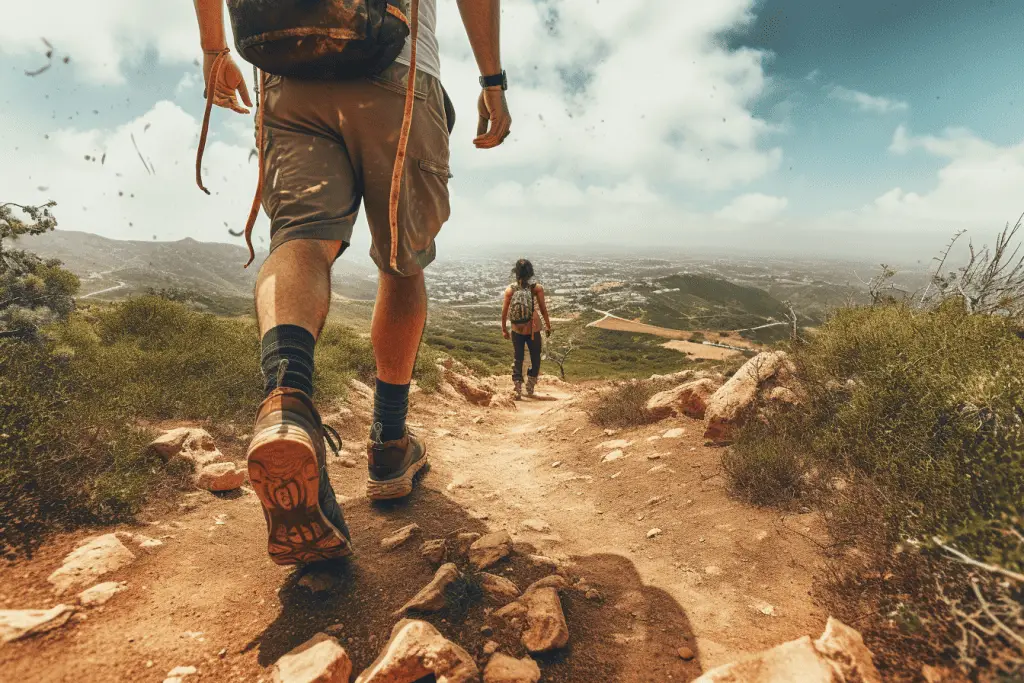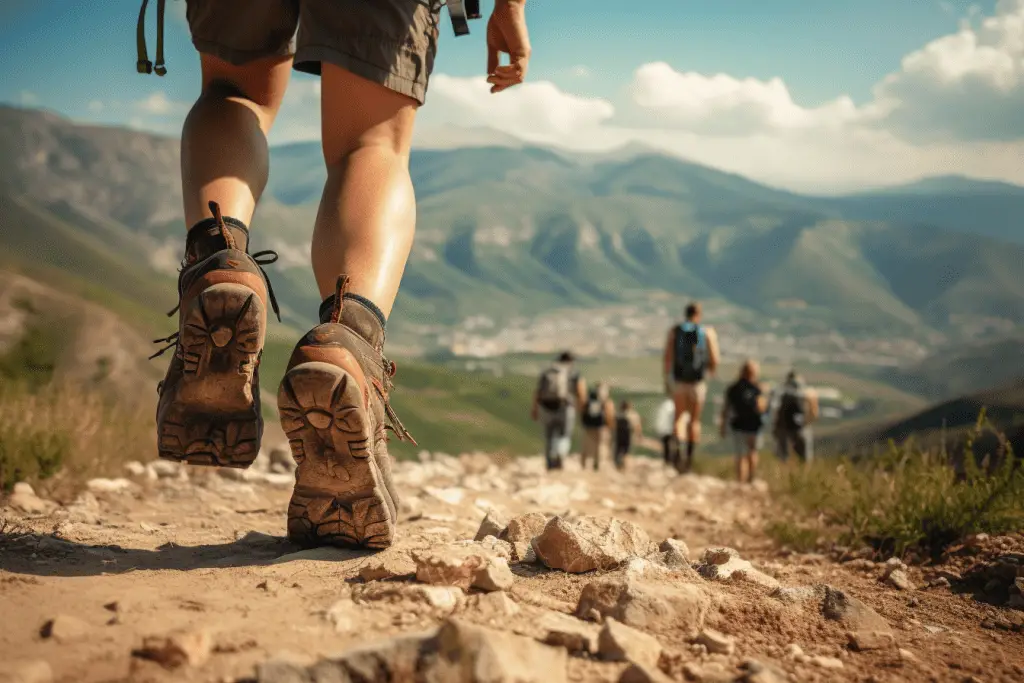You’ve probably seen them on the feet of adventurous souls, trekking through trails with their toes exposed to the elements. Yes, we’re talking about hiking sandals. These aren’t your regular beach flip-flops or your run-of-the-mill summer slides, no sir. These bad boys are a whole different breed, designed specifically for outdoor exploration and long walks in nature. They’ve been around for a good while and have earned a place in the gear locker of many hiking enthusiasts.
Hiking sandals, as the name implies, are a form of footwear made particularly for the rigors of outdoor walking. Think of them as a cross between a sturdy hiking boot and your everyday sandal. They give you the breathability and comfort of the latter, coupled with the robustness and support you’d expect from the former. Whether you’re crossing a shallow stream, clambering over rocks, or taking a leisurely stroll on a forest trail, these versatile sandals have got you covered. But are they the right choice for everyone? That’s the question we’ll be addressing in this post. So, stick around and let’s delve into the world of hiking sandals.

History and Evolution of Hiking Sandals
Ah, a history lesson! But don’t worry, I promise this won’t be a boring lecture. The story of hiking sandals is as rich and exciting as the trails they’ve been worn on. If we rewind the clock a bit, we’ll find ourselves looking at some of the earliest footwear ever crafted by humans – sandals. These were used by our ancestors for a whole host of reasons, much like today. But over the years, they’ve been modified and enhanced, eventually leading us to the rugged and resilient hiking sandals we see today.
The creation of hiking sandals was born out of necessity. Traditional boots were great for protection, but they could also be hot, heavy, and restrictive. Outdoor enthusiasts needed something lighter, more breathable, and easier to pack. It wasn’t until the late 20th century when a few brands like Tevas, took the leap to create footwear that combined the sturdiness of hiking boots and the comfort and lightness of sandals. And, thus, the hiking sandal as we know it was born.

Over the years, the design and technology behind hiking sandals have continually evolved. We’ve seen companies integrate features like adjustable straps for a better fit, advanced materials for more comfort, and rugged soles for better grip. Some even include a toe guard for added protection. All these innovations are in pursuit of creating a footwear that is perfect for the casual stroller and the hard-core trekker alike.
So, you see, the hiking sandal has been a long time coming. It’s more than just a passing trend; it’s a product of our desire to explore nature with more ease and comfort. As we continue down this path, who knows what exciting innovations the future holds for hiking sandals?
Key Features of Hiking Sandals
Let’s cut to the chase and start dissecting these outdoor bad boys. If you’re going to choose hiking sandals for your next adventure, you need to know exactly what you’re stepping into, right? Here’s what sets hiking sandals apart from your everyday flip-flops or even most hiking boots.
Hiking Sandal Soles
First off, let’s talk about the soles – these are no ordinary slabs of rubber. Hiking sandals feature rugged, often multi-layered soles designed to offer excellent traction on various terrains. They’re made to help you stay upright whether you’re navigating through slick rocks by the river or hiking up a dusty trail. You’ll also find that these soles provide some much-needed cushioning, which can make all the difference during a long hike.
Hiking Sandal Uppers
Next, let’s look at the upper part of the sandal. Unlike regular sandals that may have flimsy straps, hiking sandals come with robust, often adjustable straps. These straps are designed to keep your foot secure and stable, minimizing the risk of blisters or injuries. Some models even offer a closed-toe design for those who want extra protection for their little piggies.
Hiking Sandal Materials
And we can’t forget about the materials. Hiking sandals are typically made from durable materials that can withstand the harsh conditions of the great outdoors. Whether it’s water-resistant textiles or quick-drying synthetics, the materials used in hiking sandals are chosen for their functionality and longevity. Plus, they need to be comfortable because nobody wants to hike in something that feels like a medieval torture device. The good news is that many of today’s hiking sandals strike a great balance between comfort, durability, and style.
So, there you have it, the key features of a good hiking sandal: a rugged sole, secure and adjustable straps, and tough, comfortable materials. Keep these in mind when you’re picking out your next pair!
The Pros of Wearing Hiking Sandals
Alright, now that we’ve talked about what makes up a good hiking sandal, let’s dig into why you might want to lace up – or should I say, strap up – a pair for your next outdoor adventure.
Breathability
Hiking in warmer conditions or long trails can often lead to hot and sweaty feet, which, let’s be real, is no one’s idea of fun. This is where the hiking sandals come to the rescue with their top-notch breathability. Their open design allows for excellent air circulation around your feet, keeping them cooler and drier. It’s like a breath of fresh air for your feet, quite literally.
This improved ventilation doesn’t just offer comfort, though. It also helps reduce the risk of blisters and other skin irritations that can arise from a hot and moist environment inside your shoes. So, you’re looking at more comfortable and healthier feet if you choose to hit the trails in hiking sandals.
Lightweight
Carrying heavy loads while hiking is a challenge, and this includes the weight on your feet. Hiking sandals, being typically lighter than their boot counterparts, can make a noticeable difference, especially on longer hikes. Every step you take with less weight can help you conserve energy and keep fatigue at bay, which means more miles and smiles!
But the benefits of a lighter shoe don’t stop there. Hiking sandals are also easier to pack. They can often be flattened or stacked in a way that boots can’t, which saves valuable space in your backpack. More room for snacks, extra gear, or souvenirs? Yes, please!
Versatility
The Swiss Army knife of footwear – that’s what we like to call hiking sandals. They’re designed to tackle various terrains and conditions, from rocky trails and sandy beaches to slippery streams. They also transition seamlessly from the outdoors to more urban environments, so there’s no need for an extra pair of shoes if you plan on exploring a local town after a day’s hike.
Moreover, hiking sandals are just as at home in a casual setting as they are on the trail. You can easily wear them around your campsite or for a casual walk in the park. So, if you’re looking for a piece of gear that offers bang for your buck and versatility in spades, hiking sandals should definitely be on your list.
Easy Maintenance
The last thing you want to deal with after a long day on the trail is complicated shoe maintenance, and that’s another reason hiking sandals are a hit. They’re generally much easier to clean than boots. Often, a quick rinse under a tap or in a stream is all they need to get rid of dust and grime.
Many hiking sandals also dry quickly, thanks to the breathable materials used in their design. This is particularly handy if you’ve been crossing streams or have been caught in a downpour. Quick-drying also means they’re less likely to develop unpleasant odors, making them a more hygienic option for multi-day trips. All in all, the easy maintenance of hiking sandals is a significant plus for hikers who like to keep things simple and convenient.
The Cons of Wearing Hiking Sandals
Hiking sandals aren’t without their downsides. They offer less protection, limited ankle support, increased exposure to the elements, and less insulation. Let’s dive into this in a little more detail.
Reduced Protection
The trade-off for the breathability and lightness of hiking sandals is that they offer less overall protection compared to hiking boots. The exposed design means your feet are more vulnerable to cuts and scratches from sharp objects or rough terrain. So, if your hiking plans involve rocky landscapes or off-trail exploration, you might need to consider if the extra breathability is worth the potential risk.
It’s not just about physical injuries, though. The open design also leaves your feet exposed to the weather. While this is a boon in warm conditions, it could be a disadvantage if you get caught in a downpour or have to navigate through puddles or wet grass.
Limited Ankle Support
Ankle support is one of the key things to consider when selecting hiking footwear. This is where hiking sandals might fall short for some people. Unlike boots, sandals don’t provide much, if any, ankle support. This lack of support could be a problem if you’re planning to hike on uneven or challenging terrains or if you’re prone to ankle injuries.
That being said, not all hikes require high-ankle support. If you’re sticking to well-maintained trails or relatively flat terrains, you might not miss the ankle support at all. But it’s definitely something to keep in mind when making your choice.
Increased Exposure to Elements
One thing to bear in mind with hiking sandals is that your feet are much more exposed to the elements. This could mean everything from the harsh rays of the sun to unexpected rain showers. Sunscreen and a waterproof bag might become essential companions on your hike if you opt for sandals.
There’s also the matter of nature’s little critters. When wearing hiking sandals, your feet are more accessible to bites and stings from insects, and potentially to harmful plants as well. So, don’t forget to pack your bug spray and watch your step!
Sand and Debris Entry
While the open design of hiking sandals is great for breathability, it does have its drawbacks. One notable one is that it can allow small stones, sand, and other debris to get inside your shoes. This can cause discomfort and even lead to blisters in some cases. If your hiking route involves a lot of sand or loose gravel, this could become an annoying issue.
There are some hiking sandals with closed-toe designs that help to mitigate this problem, but it’s an aspect that you’ll need to consider. After all, nobody wants to keep stopping to shake out their shoes!
Lower Insulation
Lastly, if your hiking adventures take you into colder climates, you might find that hiking sandals fall short in terms of insulation. Unlike boots or closed shoes, they can’t keep your feet warm in chilly conditions. This could make your hike uncomfortable or even risky in cold weather or snowy conditions.
If you’re a fair-weather hiker, this might not be a major concern. But for those who enjoy year-round hiking or live in colder climates, it’s an important factor to consider when choosing between hiking sandals and more insulated footwear options.
Comparing Hiking Sandals to Other Hiking Footwear
When it comes to hiking footwear, there’s no one-size-fits-all solution. The choice between hiking sandals and other types of hiking footwear, like boots or shoes, often depends on the specific circumstances and personal preferences. So, let’s dive into how these options stack up against each other.
Boots vs Hiking Sandals
Boots have long been the go-to choice for hikers, thanks to their solid protection, excellent traction, and ankle support. They’re designed to handle tough terrains and long treks. However, their robust construction also means they’re often heavier, less breathable, and take longer to dry if they get wet. In contrast, hiking sandals are lighter, highly breathable, and quick-drying, but they lack the comprehensive protection and support that boots offer.
Boots vs Hiking Shoes
Hiking shoes, a middle-ground option, combine some of the advantages of both. They offer more protection and support than sandals but are lighter and more breathable than boots. However, they still don’t match the breathability of sandals or the support of boots, so they might not be the best option if your needs lean strongly towards either of these areas.
Making Your Choice
In the end, the best hiking footwear for you depends on a range of factors, including the terrain and climate you’ll be hiking in, the length of your hikes, and of course, your own comfort. Some hikers even choose to bring along a pair of hiking sandals along with their boots or shoes, especially for multi-day trips. This way, they have the option to switch between them depending on the day’s conditions. It’s all about finding the right balance that works for your hiking needs.
Understanding the Terrain: Where are Hiking Sandals Most Appropriate?
One of the most important factors to consider when choosing hiking footwear is the terrain you’ll be tackling. Different types of hiking footwear excel in different environments, and knowing where hiking sandals shine can help you decide if they’re right for your adventure.
Hiking sandals are generally best suited to well-maintained trails with less rocky or rugged terrain. They’re excellent for paths where you won’t encounter too many sharp rocks or roots that could cause injury. These sandals are also a top pick for hikes involving water, whether it’s crossing streams or walking along a beach, thanks to their quick-drying capabilities.

On the flip side, hiking sandals might not be the best choice for very uneven terrains, steep inclines, or off-trail hiking. The lack of ankle support can increase the risk of sprains or falls in these conditions. Similarly, if the trail is full of loose debris like small stones or gravel, you might find these nuisances creeping into your sandals more often than you’d like.
Hot and dry climates are where hiking sandals truly come into their own. The breathability offered by their open design can be a huge comfort advantage in these conditions. However, in colder climates or in snowy conditions, the lack of insulation can be a drawback.
Ultimately, understanding the terrain and climate of your hike is key in deciding whether hiking sandals are the most appropriate footwear. But remember, everyone’s experience is unique, so what works for one person might not work for another. It’s always worth trying different options and finding out what works best for your personal comfort and safety.
Health and Comfort: How Hiking Sandals Affect Your Feet
When it comes to any footwear, comfort is king – and hiking sandals are no exception. After all, an uncomfortable pair of shoes can turn an enjoyable hike into a painful ordeal. So let’s talk about how hiking sandals can impact your feet, both from a health and comfort perspective.
Aiding Foot Health
First, the good news. Hiking sandals, thanks to their open design and breathability, can keep your feet cooler and reduce sweating, which is a plus for overall foot health. Less moisture means less chance for blisters and foot infections like athlete’s foot. The lighter weight of sandals can also reduce strain on your feet, ankles, and legs, especially over long distances.
Potential Risks and Limitations
On the other hand, hiking sandals offer less protection to your feet than boots or closed shoes. This increases the risk of cuts, scrapes, or bruises from obstacles on the trail. The lack of ankle support can also pose an issue, particularly for those with weaker ankles or if you’re hiking on uneven terrain.
Arch Support Considerations
Foot arch support in hiking sandals varies widely from brand to brand and model to model. Some offer excellent support comparable to more traditional hiking shoes, while others might fall short. If you have specific needs in terms of arch support or have foot conditions like plantar fasciitis, it’s crucial to look for a pair of hiking sandals designed with these considerations in mind.
Conclusion
In summary, hiking sandals can offer a high level of comfort for your feet, especially in warm conditions or on gentle trails. However, they also come with certain risks and limitations, which means the choice to wear them should be balanced with an understanding of the specific demands of your hike and the needs of your feet.
Choosing the Right Hiking Sandals: A Comprehensive Guide
Before you start shopping, it’s crucial to understand your needs. Consider the type of hiking you’ll be doing, the terrain and climate you’ll face, and any specific requirements your feet may have. For example, if you’re going to be hiking in hot weather or across waterlogged terrain, a breathable and quick-drying pair of hiking sandals might be ideal.
Key Features to Look For
Once you’ve defined your needs, there are several key features to look out for when choosing hiking sandals.
- Fit and Comfort: Just like any other shoes, your hiking sandals should fit well. They should be snug but not tight, with enough room to wiggle your toes. Pay attention to the strap placement and adjustability to ensure they won’t rub and cause blisters.
- Arch Support: Depending on your feet, you may need more or less arch support. Some sandals offer excellent arch support comparable to hiking shoes, while others are more flat. If you need more support, look for sandals with a contoured footbed.
- Traction: Look for sandals with a good tread pattern on the sole for grip. This is especially important if you’ll be hiking on wet or slippery surfaces.
- Durability: Durable materials and construction are a must, especially for longer or more challenging hikes. Look for sandals made from sturdy materials that can withstand the elements and the rigors of the trail.
Try Before You Buy
Always try on hiking sandals before you buy them, if possible. Walk around, try them with any hiking socks you plan to wear, and even try them on different surfaces. This will give you the best idea of whether they’re comfortable and suitable for your needs.
Customer Reviews and Expert Opinions
Finally, do your homework. Check out customer reviews and expert opinions. These can provide invaluable insights into factors like durability and comfort that you can’t judge just by looking at the sandals. However, remember that everyone’s feet and preferences are different, so what works for one person might not work for you.
Maintenance and Care Tips for Hiking Sandals
Just as with any important piece of gear, taking good care of your hiking sandals can extend their lifespan and ensure they perform at their best when you’re out on the trail. This means more than just hosing them down after a particularly muddy hike – proper maintenance and care involve regular cleaning, inspections for wear and tear, proper drying and storage practices.
Cleaning Hiking Sandals
Keeping your hiking sandals clean is crucial for their longevity. After each hike, remove any loose dirt or debris. For a more thorough cleaning, use mild soap and a soft brush to gently scrub the sandals, paying extra attention to the footbed and straps where sweat and dirt can accumulate. Be sure not to use harsh detergents or hard brushes that could damage the material.
Drying Your Sandals
Proper drying is another critical step in the care of your hiking sandals. Never expose them to direct heat or leave them in a hot car, as this can warp the soles or cause the glue that holds them together to deteriorate. Instead, let them air dry in a well-ventilated area away from direct sunlight.
Regular Inspections
Regular inspections can help spot any wear and tear early on. Look for areas where the sole might be wearing thin, any fraying on the straps, or signs of the sandal coming apart. Catching these issues early can help you to take action before they become a problem and could extend the life of your sandals.
Proper Storage
When you’re not wearing your hiking sandals, proper storage is essential. Store them in a cool, dry place out of direct sunlight. Avoid piling other shoes on top of your sandals, as this could cause them to lose their shape over time. If your sandals have adjustable straps, loosening them before storage can help prevent unnecessary strain on the material.
Taking care of your hiking sandals doesn’t have to be complicated. With a little routine maintenance, you can keep them in good shape and ready for many hiking seasons to come. After all, a well-cared-for pair of sandals is a happy pair of sandals!
Final Verdict: Are Hiking Sandals Right for You?
The decision to lace up hiking sandals versus traditional boots or shoes really boils down to your personal preferences, the nature of the trails you’ll be exploring, and the climate conditions. They offer some unique benefits, including enhanced breathability, quick drying, and less weight to carry on your feet, which make them perfect for certain circumstances, like hiking in hot weather or crossing streams. However, they also come with some trade-offs, such as reduced protection and potentially less support, which could be concerning if you’re tackling rougher terrains or have specific foot health considerations.
In the end, it’s all about finding what makes your hiking experience enjoyable and comfortable. If you’re intrigued by the concept of hiking sandals, there’s no harm in giving them a go. Remember, many hikers carry a pair of sandals in addition to their boots on multi-day hikes for those times when boots may be too heavy or uncomfortable. Whatever you choose, make sure you prioritize your comfort and safety to ensure your adventures in the great outdoors are unforgettable for all the right reasons.
